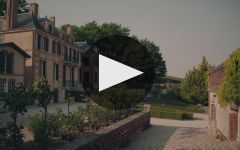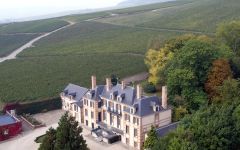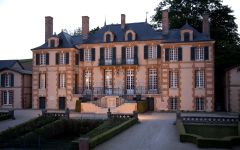Taittinger Comtes de Champagne Blanc de Blancs with Gift Box 2011
-
James
Suckling - Decanter
-
Robert
Parker -
Wine
Spectator



Product Details
Your Rating
Somm Note
Winemaker Notes
A powerful, refined, expressive and complex Champagne, with notes of citrus fruits, lime blossom and caramelized grapefruit. The long, rich ending reveals sweet licorice aromas.
Professional Ratings
-
James Suckling
A firm, fresh Comtes with a tight and composed palate. It’s full-bodied with a racy mid-palate. Long and persistent. Very structured with phenolics and acidity. Minerally. Floral, too. Refreshing and energetic. September 2021 release. Drink or hold.
-
Decanter
100% Chardonnay sourced from five grand cru villages: Avize, Chouilly, Cramant, Mesnil-sur-Oger and Oger. Superb bouquet revealing scents of mirabelle plums, orchard fruits, brioche, pastry, and liquorice, complicated by classy autolytic notes. On the palate, this remarkable 2011 has a tauter and more fine-boned texture than usual, which is enhanced by bubbles of striking finesse and delicacy. This is indeed a very refined, chamber-music-like Comtes de Champagne that ends ethereally with airy harmonics and chalky notes infused with candied lemon. Dosage: 9g/L.
-
Robert Parker's Wine Advocate
After the tightly coiled, hyper-concentrated 2008, Taittinger's 2011 Brut Blanc de Blancs Comtes de Champagne represents a more immediate, charming rendition of this cuvée. Bursting from the glass with aromas of orchard and stone fruit mingled with notions of pastry cream, blanched almonds and mandarin, it's medium to full-bodied, pillowy and fleshy, with a soft and enveloping profile, lively acids and a pretty pinpoint mousse. Readers might think of the 2011 as a somewhat less reductive and less intense stylistic sibling of the 2006, and as it takes on more toasty complexity with bottle age, it will make for immensely seductive drinking.
-
Wine Spectator
A minerally version, with smoke and saline notes deftly meshed with flavors of glazed apple, lemon-infused pastry cream and marzipan. This is fine and softly creamy in texture, with lemony acidity providing good definition through to the lightly toasty finish. Elegant. Drink now through 2030.
Other Vintages
2013-
Wine
Enthusiast -
James
Suckling -
Robert
Parker - Decanter
-
James
Suckling -
Jeb
Dunnuck -
Wine
Spectator -
Robert
Parker
-
James
Suckling -
Robert
Parker -
Wine
Enthusiast -
Wine
Spectator
-
James
Suckling -
Tasting
Panel -
Wine
Enthusiast -
Robert
Parker -
Wine &
Spirits -
Wine
Spectator - Decanter
-
Wine
Enthusiast -
Wilfred
Wong -
Wine
Spectator -
Connoisseurs'
Guide








Champagne Taittinger was established in 1931 by Pierre Taittinger on the foundations of Forest-Forneaux, itself established in 1734 and the third-oldest wine producing house of Champagne. Taittinger is today proprietor of approximately 600 acres of vines among which are included parcels in the one hundred - percent rated villages of Cramant and Avize in the Cote des Blancs; and Bouzy, Mailly, Ambonnay and Verzenay in the Montagne de Reims. The Taittinger Estate is one of the three most extensive in the Champagne district, and the firm's major holdings in Chardonnay vineyards are the physical expression of the Taittinger philosophy and style.

Representing the topmost expression of a Champagne house, a vintage Champagne is one made from the produce of a single, superior harvest year. Vintage Champagnes account for a mere 5% of total Champagne production and are produced about three times in a decade. Champagne is typically made as a blend of multiple years in order to preserve the house style; these will have non-vintage, or simply, NV on the label. The term, "vintage," as it applies to all wine, simply means a single harvest year.

Associated with luxury, celebration, and romance, the region, Champagne, is home to the world’s most prized sparkling wine. In order to bear the label, ‘Champagne’, a sparkling wine must originate from this northeastern region of France—called Champagne—and adhere to strict quality standards. Made up of the three towns Reims, Épernay, and Aÿ, it was here that the traditional method of sparkling wine production was both invented and perfected, birthing a winemaking technique as well as a flavor profile that is now emulated worldwide.
Well-drained, limestone and chalky soil defines much of the region, which lend a mineral component to its wines. Champagne’s cold, continental climate promotes ample acidity in its grapes but weather differences from year to year can create significant variation between vintages. While vintage Champagnes are produced in exceptional years, non-vintage cuvées are produced annually from a blend of several years in order to produce Champagnes that maintain a consistent house style.
With nearly negligible exceptions, . These can be blended together or bottled as individual varietal Champagnes, depending on the final style of wine desired. Chardonnay, the only white variety, contributes freshness, elegance, lively acidity and notes of citrus, orchard fruit and white flowers. Pinot Noir and its relative Pinot Meunier, provide the backbone to many blends, adding structure, body and supple red fruit flavors. Wines with a large proportion of Pinot Meunier will be ready to drink earlier, while Pinot Noir contributes to longevity. Whether it is white or rosé, most Champagne is made from a blend of red and white grapes—and uniquely, rosé is often produce by blending together red and white wine. A Champagne made exclusively from Chardonnay will be labeled as ‘blanc de blancs,’ while ones comprised of only red grapes are called ‘blanc de noirs.’
